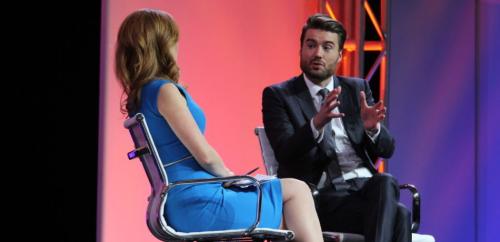“It’s a great time to be a content creator,” said Mashable CEO Pete Cashmore during Tuesday’s general session at INTX. Cashmore addressed the audience from the main stage along with other big “disruptors” in the technology and television space, and described the new media landscape as being more “data-driven” and competitive than ever.
CEO of AT&T Entertainment Group John Stankey’s message was also clear when he said the industry was at a vibrant point in time. “There’s a lot of competition, a lot of value out there. That seems to be the winning combo,” said Stankey. Then there was FanDuel CEO Nigel Eccles, who heads the leading one-day fantasy sports company that is redefining sports entertainment. During his interview, Eccles emphasized the effective targeting methods out there that have helped his business find out exactly where the fans are on sports television as well as in the digital sphere.
In going back to Mashable, Cashmore hit it home when he remarked, “We as a digital media company have always had to fight for distribution.” This says a lot coming from someone whose company was there at the very start of the social media revolution.
In a one-on-one conversation with Julia Boorstein, CNBC correspondent, Cashmore talked about Mashable’s Velocity, a tool that collects data from the web and helps to predict how people will engage with published pieces. Velocity helps drive consumption and engagement more efficiently.
Our readers want to know what’s new, what’s next in media and across the web, said Cashmore, so logically this type of predictive technology is a big advantage in video and television. Television companies need to also ask themselves, how do we make a hit show? What IS a hit show now? Velocity can actually target the right people for a particular show.
It’s interesting, maybe even ironic to say the least, to see a company like Mashable that has built its existence on the digital platform to start to transition to what some people call old fashioned television. But Cashmore drove home the point that today, stories have to be told over multiple platforms. Gone are the days of singular platforms.
Even Kayvon Beykpour, CEO and co-founder of Periscope, which was named Apple’s App of the Year for 2015, said competition was a huge driver to success in today’s crowded media environment. Periscope is a video streaming app that was acquired by Twitter and lets people broadcast live video. When asked by Recode journalist Peter Kafka how it feels to have to compete with Facebook, which is transitioning to live video streaming, Beykpour’s response was a positive one: “We are flattered that what we’ve done is good enough that others want to jump into the space.” Basically, his message was that the best reaction to competition is to double-down and to continue to build a product that people want to use.
The media tends to dramatize competition between reputable companies, but the reality is that Periscope was not the first one in the live streaming apps pool. “We wanted not to be first, but to be different.” And that philosophy is what has helped Bekypour launch Periscope into the product we have come to know.
So why is live content all the craze nowadays? Because of this: “I can, at the snap of my fingers, walk down the street and command the attention of thousands,” said Beykpour. Novelty is what drives consumers to check out a product. But the interaction of that product is what gets them to stay.
With all the different players in the new media economy space right now, there’s no doubt that competition will only make live content even better and more engaging. Like Cashmore said, it’s a thrilling time to be a content creator.
And an even more exciting time to be a consumer.
Mashable’s Pete Cashmore Talks on the Power of New Media at INTX 2016 from The Internet & Television Expo on Vimeo.
